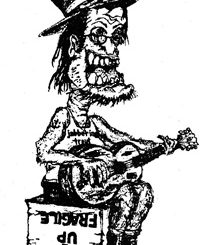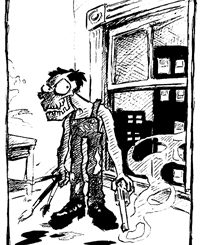 Hello Kitty, Goodbye!
Hello Kitty, Goodbye!
by Kerry Joyce
illustration by Tom Powers
“The Supreme Art of War Is To Make the Enemy Look Foolish” -Li Atwater
The Scene: A Cinemaplex in Lawrence, Massachusetts, birthplace of Leonard Berstein. It’s a winter’s evening in 1994 and the credits are rolling downward as the hit movie The Joy Luck Club comes to its stellar, emotional, button-pushing finish. Likewise, falling downward are the tears of the gratefully weeping theater patrons. No, weeping doesn’t quite cover it. People wept when the Kennedy boys were shot. They blubber at the end of The Joy Luck Club. Even here, in Lawrence, (Leonard Who?) Massachusetts, the poorest, most wretched and hopeless place in all of New England, the scene is a panorama of Kleenex, lowered heads, and heaving shoulders. There’s more pathos in front of the screen than there was at any point on it. Note to self: “If this isn’t Orwellian, it’s at the very least damned peculiar.” Second note to self: “You’re out of Kleenex.”
Spring forward to the year 2000. No tears of empathy for our Eastern brethren in that most populous of nations these days. The Chinese are on the outs again. Not for the first time.
A quick review: During the forties, what with World War II and all, the Chinese, with friends like Pearl Buck and Henry Luce at Time Magazine, were most definitely in, while the Japanese (see Pearl Harbor) were decidedly out. After World War II, the Chinese went communist, so the Japanese were in and the Chinese were out.
Then, Nixon and Kissinger went over to China and came back with a couple of somewhat coy but nonetheless living, breathing pandas. In addition, some of Nixon’s many allies in the media followed his visit up with a hit television series, Kung Fu. Presto! The Chinese were back in, while the uppity Japanese were out. Their annoying little cars, motorcycles, TVs, and stereos, though, remained in.
It stayed that way for some time. Sure, a few hair-splitters would remind people about Tiennamen Square after 1989, but at least they weren’t communist anymore. Or at least they weren’t as communist as they used to be.
There was still no answer to that ancient riddle: “How come it always turns out that the very worst people seem to wind up with most of the very best stuff?” Even the Chinese seemed to acknowledge that communism didn’t have the answer, albeit tacitly.
But we had all watched Kung Fu and understood that a tacit agreement was really the best you could hope for when dealing with the Chinese. It was either a tacit agreement or a swift foot to the mouth, at least on the show.
The Japanese stock market crashed in ’98, and now Japan doesn’t seem quite so threatening. Japan is blessedly back in, while China, already guilty of being big, populous, and powerful, has only exacerbated matters by behaving in a way that is indiscreet to the point of boldness. This is something that watching Kung Fu simply never prepared us for. China therefore is definitely out.
Emerging cues from the establishment can be found in the upcoming show trial of Los Alamos physicist Wen Ho Lee. The way you can tell that there will be a show trial is that he is only charged with security breaches, instead of espionage. Curious at first glance, since a Senate report disclosed that “Lee failed a polygraph test early this year in which he was asked whether he had passed nuclear secrets ‘to any unauthorized person,'” according to the Washington Post.
Now, in most normal countries, show trials usually involve exaggerated charges. Dissidents and POWs, for example, are routinely charged with espionage. With American show trials, it’s frequently the opposite. Our show trials often involve lighter charges: Alger Hiss, suspected of espionage, charged with perjury; Al Capone, suspected of gangland activities, charged with tax evasion; Whitey Bulger, another suspected high-profile mobster and lucky Mega-Bucks jackpot winner, if ever caught, will most likely be charged with failing to cash his lottery checks.
The major media, of course, is slavishly following the government’s lead, using the Chinese as a convenient foil for the annual Christmas Present Scare Story. A few days after Wen Ho Lee was charged, an article from the Kansas City Star picked up by the Associated Press reported that “Investigators have discovered that Chinese factories are using real cat pelts in some cat figurines sold in the United States. Telling the difference between figurines with real cat fur, rabbit fur, or other materials requires an expensive forensic test,” it said.
Nothing in the article reveals just who these “investigators” are. Did these investigators give expensive forensic tests to Chinese stuffed toys last year? What about the year before? Where can the average consumer have his or her Christmas gifts tested? Or should American kids settle for figurines that feel like sandpaper as a precautionary measure?
At the same time, Salon, the establishment’s pseudo alternative on the World Wide Web, ran a fawning article about the Japanese turd craze. Salon reported: “The turd – presented in Japan as a prettified swirl resembling soft ice cream – has become a recurring motif in Japanese pop culture. There’s even a term for it – maki guso – which roughly translates as ‘curlicue poo.'” The turd “motif” recurs in the form of candy, plastic jewelry, even as a popular animated cartoon character, according to the article.
It’s only a matter of time before “maki guso,” like Godzilla and Hello Kitty, makes its foray from Japan into our own culture, while America’s governing elite look the other way as part of some Byzantine foreign policy gambit. And when will the expensive DNA tests be run on this curious import? When China is once again subdued and Japan is back on the “curlicue poo” list, that’s when.



